Abstract
The purpose of this dissertation is to identify the present situation and future trend regarding privatisation of public healthcare system in the Kingdom of Saudi Arabia; in addition, it aims to suggest a right direction to carry on public healthcare privatisation in the KSA in order to reduce governmental resource allocation, improve the healthcare management system, and maximise welfare for the citizens. Through an analysis of both primary and secondary data, this research will represent that the ongoing initiatives of public health sector privatization in Saudi Arabia attained fewer achievements than its target and failed to generate the positive impact on the citizens in terms of enhanced public health services delivery.
The findings of this study will point out the rising challenges of the public healthcare system; however, the recommendations will present the best possible direction to improve the healthcare management system by introducing a dynamic public, private partnership, which will generate new resources for public healthcare financing and advance service delivery process and ensure citizens’ trust and satisfaction.
Problem Statement
Introduction
This dissertation critically investigates the public healthcare privatisation programmes, which were put forward by the Ministry of Health (MoH) of KSA in order to decrease the expenditure of the government for healthcare, improve the management system, and generate a standard healthcare system that will ultimately bring a satisfactory level of health care system for the people of this nation. The process of privatising public healthcare system has challenged by the different socioeconomic realities while the involvement of ‘WHO’ and other foreign elements made it mandatory for the government to introduce a public health policy to secure the interest of the citizens, donors, business organisations, and another stakeholder.
In the changing economic dynamics of the modern world, the growing requirement for improved public healthcare service has created serious pressure on the government budget allocation while limited resources and scarcity of state services have threatened the quality of better life index; as a result, the experts are increasingly emphasising to reduce the dependency on state-financed public healthcare services.
This dissertation has organised with six major chapters and sub-chapters; however, it includes problem statement (dealing with the underlying dilemmas of privatisation of public healthcare), literature review (it comprises the major theoretical standpoints of the entire study), methodology (that explores the way out of the research process), the findings (prepared from the collected primary data), discussions, recommendations, and conclusion.
Background of the Problem
The public healthcare system of KSA is facing serious challenges due to privatization; the Ministry of Health has already taken different initiatives to reduce budget allocation for public healthcare, for instance, selling out governmental hospitals to the private sector, and providing incentives to the private operators in the healthcare market (Almalki, Fitzgerald & Clark 2011).
As a result, the public service in the healthcare sector and easy access to the medical facilities have been reducing quickly and generating serious pressure over the lifestyle of the citizens to carry on elevated expenditure for healthcare, which was ultimately going beyond the public tolerance. The healthcare privatisation process of KSA has dramatically attracted the foreign and local business houses to invest in the healthcare market of the Arabian Kingdom, and it gradually commercialised the public health care system of KSA and pointed question mark to the criteria of a welfare state.
Bagaresh (2013) and Albejaidi (2010) argued that the government of Saudi Arabia introduced public health service in the country in 1978 following the prescription and guidance of the international organisation ‘WHO’; however, the government set up the Saudi health strategy to attain access to public healthcare for all by 2000.
Within 2004, such health strategy of KSA has resulted with 1787 state-operated healthcare centres all over the country where 8727 individuals facilitated with primary medical services; however, these centres incorporated child healthcare, vaccination, specialist appointment, prescription, chronic disease management, maternal health care, health education, and so on. Within two decades of introducing public healthcare system, the demand for quality healthcare service had increased remarkably and shaped it as a multidimensional concept among the people, but the policy-makers have shifted from their strategic alignment, engaged in reducing budgetary allocation for this purpose, and patronised private operation of medical services.
The citizens’ awareness for public healthcare service has progressed in a stage where people urged to increase the effectiveness of KSA healthcare services, eradicate the barriers to ensure a better quality of healthcare system, improve the hospital management system, enhance organizational factors, provide an adequate level of evidence-based medicine, and expand the professional development strategies for secondary care.
With such background problems of the Saudi public healthcare sector, this dissertation has engaged in conducting a comprehensive study with the privatisation of public healthcare system with the aim to diminish expenses by arranging alternative resources to mitigate increasing cost of medical services through medical insurance and addressing the issues related with the corporate social responsibility of the private operators.
Rationale of the Research
There are very inadequate numbers of researches regarding the public healthcare system in KSA though there are enormous studies with the privatisation strategy of the Saudi government; however, no research agenda has been put forward to deal with the impact of public health sector privatisation policy of the government, its progress, and social impact on the citizens. In the concurrent situation, the public healthcare system in Saudi Arabia is facing a severe crisis with poor accessibility to the healthcare services, scarcity of native health professionals, and increasing demand to get state-backed health service, sustainable health policy, undemocratic management, and lack of community participation.
Thus, it is essential to conduct a wider study with the possible privatisation of public healthcare system in KSA; however, the investigation of the current healthcare system and recommendation for the future trend of the public healthcare system will contribute to ensuring the maximisation of the best use of resources with public satisfaction and enhanced business prospect. With this rationale of the research, this dissertation will expand a conceptual framework in this study that will eventually extend a hand to facilitate the business and academia with a greater understanding in this area.
Aim and Objectives of the Research
The research looks forward to assessing the entire privatisation initiatives of the public healthcare system of KSA and its socioeconomic impact on the citizens that will assist the policy-makers to set up their future health policy based on the economic reality of the limited governmental resources to meet up rising demand for medical service free of cost. In order to attain such aim and objective, this dissertation has intended to address following research questions, the reply to the questions would facilitate the readers and policy-makers with an enhanced understanding to generate new health policy with a superior motivation to integrate health insurance and new financial and technological resources; however, the designed research questions are as follows:
- How the public health sector privatization in Saudi Arabia kept potential impact on its citizens?
- What is the impact of compulsory medical insurance over the citizens and the governmental budgeting?
- How the public health policy could bring suitable balance between privatization and government spending within the health sector?
Findings and Results
The aim of this research is to analyse the privatization of public health sector in the kingdom of Saudi Arabia and consider the impact of it on the citizens and the government of this country. In order to do so, it was highly essential to conduct a field survey to better understand the real phenomena and acquire the results of the entire research. It is important to state that a questionnaire was distributed among 100 respondents to serve this purpose; among the respondents, there were people mainly from the health service providers (owners and managers), the staff of the health service sector (employees), and the beneficiaries of health care services (patients and visitors).
Personal Information
Question 1: The respondents were asked to state their gender
It is significant to mention that in the conducted survey, there were 88% male and 12 percent female respondents; however, the female respondents were mainly from the group of patients and visitors, and there were no women from employment in the health service sector:

Question 2: The respondents were asked to state their age group
In the conducted survey, 18 percent people aged between 18 and 35, 20 percent people aged between 36 and 45, 26 percent people aged between 46 and 55, 23 percent people aged between 55 and 65, 10 percent people aged between 66 and 75, and 3% people aged between above 75; however, this has been shown in the figure below:

Question 3: The respondents were asked to state the highest level of their educational qualifications
This question was asked mainly to know whether the respondents were knowledgeable enough or not. It is notable that in this field survey, 37 percent people had high school education, 32 percent people had university education, 19 percent people had tertiary institution education, and 12 percent people had never attended any schools; the result represents in the graph below:
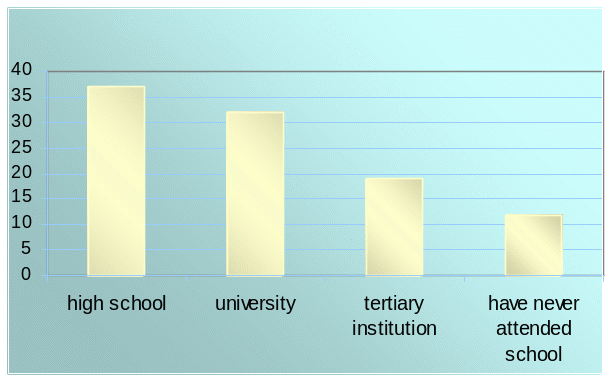
Question 4: The respondents were asked to state their current occupation
It is very crucial to acknowledge the fact that in this field research, 14 percent people were students, 23 percent people were retired, and 22 percent people had business of their own, whereas 41 percent people were professionals; however, the results illustrate below:

Question 5: The respondents were asked to state their income level per month
It is noteworthy that among 100 respondents, 24 percent people earned less than SAR 5,000, 36 percent people earned SAR 5,000 to SAR 15,000, 21 percent people earned SAR 15,001 to SAR 20,000, and 19 percent people earned above SAR 20,000:

General Questions
Question 1: To what extent the respondents think that privatising the public health sector will affect the existing hospital management
In this part of the questionnaire, most people expressed that privatising the public health sector will result in huge changes in the existing healthcare management system; this can be understood easily from analysing the survey form. In the survey form, 35 percent people had selected the ‘very high’ option, 37 percent people had selected the ‘high’ option, 20 percent people had selected the ‘minimal’ option, and 8% people had selected the ‘no effect’ option; however, the survey result demonstrates in the graph below:
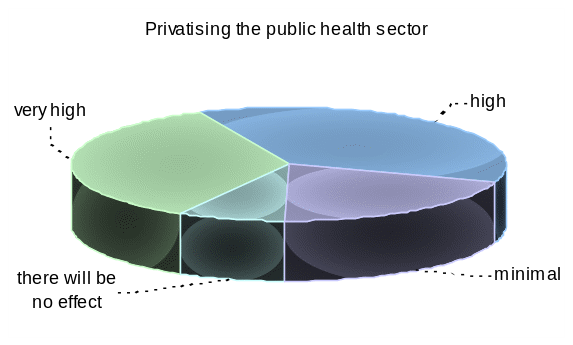
Question 2: In what ways the respondents expect that the privatisation of the Saudi Arabian public health sector has affected the primary healthcare
The reason behind putting this question forward was to know whether the respondents have taken the entire process of privatisation of the Saudi Arabian public health sector optimistically or not. From the analysis of the collected data, it has been seen that 42 percent people believed that this would improve the primary healthcare sector, 18 percent people believed that this would not improve the primary healthcare sector, while 40 percent people stated that the healthcare sector would remain the same:

Opinion of the respondents
Most people believed that this would improve the primary healthcare sector; their logic was that privatisation would increase competition among the health service providers; however, increase level of competition would ensure better quality services, and lower expenses. A significant number of people contested this concept by stating that the privatisation would mean rise in medical costs because in most of the cases private hospitals charge higher prices due to lack of governmental intervention.
Question 3: In what ways the respondents expect that privatisation of the public health service in Saudi Arabia could affect healthcare delivery in the rural areas
It was truly essential for this research to identify how the privatisation of the public health service in Saudi Arabia would affect the healthcare delivery in the rural areas; it has observed from the responses that 35 percent people believed that the health practitioners and investors would not get excited to work in the rural areas. However, the majority of the surveyed population, for example, 65 percent people believed that health practitioners and investors would get excited to work in the rural areas:

Opinion of the respondents
The majority of the respondent expressed that privatisation would increase involvement of health practitioners and investors in the rural areas because more privatisation would mean rise in creation of new hospitals in rural areas and recruiting people from the local vicinities.
Question 4: Whether the respondents think that, the privatisation of the public health sector in Saudi Arabia influences the citizen’s living standards
Privatisation of health-sector is a factor, which will undoubtedly affect the lifestyle of the citizens in certain ways; however, in this question, it was important to find out whether the respondents think that the privatisation would influence citizen’s living standards; it should note that 76 percent people said yes to answer this statement, while the rest 24 percent said no:

Question 5: The respondents were asked in what ways the living standards will be or will not be impacted
This question was the continuation of the previous question where the respondents were asked to clarify their answers, and state why they think that the living standards will be impacted or will not be impacted due to the privatisation.
Opinion of the respondents
The respondents who thought that the living standards would be impacted stated that healthcare services are something by which any person will have to depend on at certain phases of their lives; in addition, the more their health condition deteriorate with age or accidents, the more they will have to depend on it. Therefore, so much of dependency over this service would mean that people would have to pay more charges for hospitals and doctors. If privatisation increases the costs, then their living standards will be affected adversely; however, if privatisation decreases the costs, then their living standards will be affected favourably.
To answer this question, a significant part of people said no, which indicates that no matter whether a service is privatised or nationalised; however, it makes no difference in their own living standards, and ultimately they will have to earn their own living and pay for the health services they require.
Question 6: The respondents were asked how the privatisation of the public health sector in the KSA would affect the level of healthcare delivery to Saudi Citizens
In answering this question, 38 percent people said that the country would experience significant improvement in healthcare delivery, 45 percent people said that most governmental healthcare programmes would be affected adversely, and 17 percent people said that there would be no impact on healthcare delivery to citizens; however, survey result has shown in the chart below:
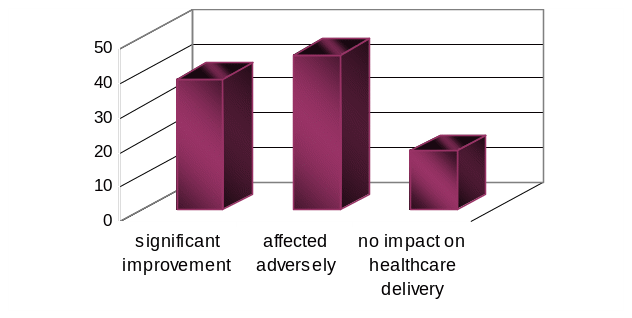
Question 7: To what extent the respondents expect that the privatisation of the public health sector in Saudi Arabia would affect the existing law on compulsory medical insurance for employees and individuals in the Kingdom
In response to this question, 25 percent people selected the ‘strongly agree’ option, 30 percent selected the ‘agree’ option, 5% selected the ‘no comments’ option, 18 percent selected the ‘disagree’ option, and 22 percent people selected ‘strongly disagree’ option; the graph below shows that most of the people believed that privatisation would affect existing law on compulsory medical insurance:

Question 7 (i): The respondents were asked whether they think that the country’s economic development and growth will be impacted by the privatisation
Indeed, the establishment of the compulsory medical insurance on Saudi citizens has played a fundamental role in enhancing the KSA government to stimulate the country’s economic growth; however, in answering this question, 62 percent people said yes, 23 percent people said no, and 15 percent people said no comments:
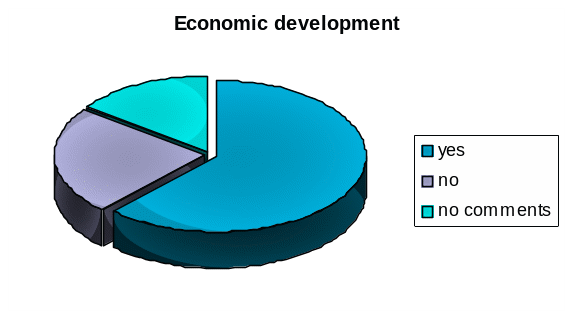
Opinion of the respondents
Most of the people strongly commented that economic development and growth would be boosted by the privatisation, as privatisation would create more jobs, more investments, higher gross domestic product, more taxation, and so on.
Question 7 (ii): In what ways the respondents expect that the privatisation of the public health sector would influence the citizens’ lifestyle, level of savings and employment opportunities
In answering this question, 38 percent people stated that savings would decrease, 26 percent people stated that savings would increase, and 35 percent people stated that savings would remain un-affected:
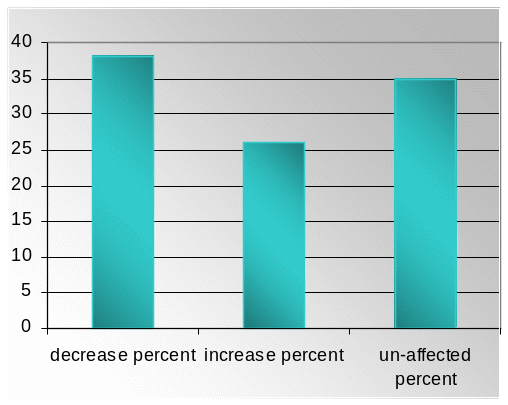
At this portion, 55 percent people stated that employment would decrease, 27 percent people stated that employment would increase, and 18 percent people stated that employment would remain un-affected:
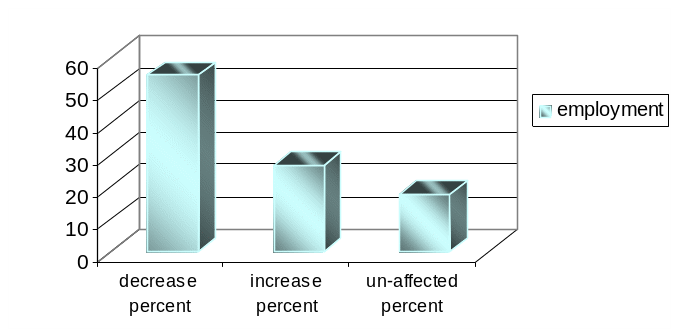
Question 8: Privatisation of the public health sector will transform the existing public hospitals in different parts of the KSA into private entities; so, the respondents were asked in what ways they expect that the cost of seeking medical services to change
This question was asked mainly to get the information of whether the respondent groups like the people from the health service providers (owners and managers), the staff of the health service sector (employees), and the beneficiaries of health care services (patients and visitors) think that the cost of the medical services is going to increase due to the privatisation.
It is remarkable to state that the health service providers (owners and managers) and the staff of the health service sector (employees) tended to note that cost and facilities of the privatised sector will be affordable and less expensive, whereas most of the beneficiaries of health care services (patients and visitors) noted that it will be more costly. The following graph shows that out of 100 respondents, 54 percent people noted that the medical costs are going to be more expensive, whereas 46 percent people noted that it would not be expensive:

The graph below shows that 43 percent people noted that the medical facilities would not be affordable or going to be affordable, whereas 57 percent people noted that it would be affordable:

Question 9: The respondents were asked to give their opinion on privatisation of the public health sector in the KSA
The question has produced a mixed set of responses from the respondent groups; some people took the concept of privatisation very positively, while others took a contrary view and thought that privatisation is going to create further problems rather than trying to solve the existing or former dilemmas. However, it is highly essential to consider the fact that in answering this question, 28 percent people noted that privatisation would increase the level of satisfaction with regard to delivery of healthcare services and 38 percent people noted that privatisation would lead to discrimination in delivery of different healthcare services between the rich and the poor. On the other hand, the rest 34 percent people noted that privatisation would improve quality of care, and good governance in the public health care sector.
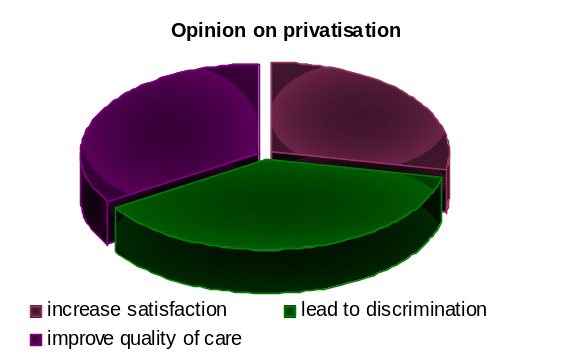
Question 10: The Saudi government funds the public health sector in Saudi Arabia through the Ministry of Health; so, the respondents were asked whether they think that the government of the KSA allocates sufficient amounts of money to the public health sector in its annual government-spending budget
The aim of this question was to identify whether the government of Saudi Arabia allows sufficient amounts of money to the public health sector in its yearly spending budget because as there has been rapid privatisation in the health service sector, there must have some issues about the public health sector. Due to some problems about the public health sector, people have shown aversion towards the public service and inclined to the private ones, for which there has been a shift towards mass privatisation. It has noted from the response of the respondents that this problem arose mainly due to the inadequate amount of funds, which the government of the country allotted to the health service sector, for which this change has occurred. To be specific, 35 percent of the respondents said yes to this question, while the rest 65 percent people said no; this result has shown in the figure below:

Opinion of the respondents
Most of the people felt that the amount of funds that the government allots for the public health service sector is not adequate because the needs and requirements of this industry is huge and compulsory medical insurance means that the expectation of the public to get the finest service is even greater. However, it is notable that to handle and satisfy such huge expectations, the instruments, machineries, technologies, and overall facilities are not developed enough for insufficiency of funds.
Question 11 (i): Considering the existing disparity with regard to the citizens’ purchasing power in the KSA, the respondents were asked to state the most effective strategy that the government should adopt in order to establish a balance between the country’s public and private health sectors
It is important to state that the Kingdom of Saudi Arabia has disparity in income of its citizens and there exists a major class difference from an overall point of view. In this context, it is quite understandable that not everyone in the Saudi society has the ability to afford the high standard services. It is essential to admit that in most of the cases, privatised hospitals charge higher amount to the patients, while the public sector hospitals tend to charge lower rates.
As a result, if there is a full privatisation of the public health sector industry, many lower income earners will be unable to afford the charges. In this situation, it is highly important for the government to establish a balance between the country’s public and private health sectors, so that people of all classes can afford the healthcare facilities. In order to establish this balance, three strategies were put forward before the respondents and they were asked which strategy would be the best suitable in context of the Saudi Arabia to fasten stability.
The first strategy is that the government should eliminate entry barriers in the public health sector in order to attract foreign direct investment, and it is notable to state that only 14 percent of the surveyed population has agreed with this strategy in real sense. The second strategy is that the government should improve quality of service delivery in the public health sector by increasing the annual allocation to the Ministry of Health rather than privatising the sector: it is highly essential to state that in the survey the largest number of the respondents had selected this strategy.
To be specific 56% of the respondents have noted this strategy to be the best one, so that there is ultimately no need to further privatise the industry and rather improve quality of service delivery in the public health sector by increasing the annual allocation to the Ministry of Health. On the other hand, it is notable that 30 percent of the respondents selected the third strategy, which is the government should undertake private-public partnership, rather than entirely privatising the public sector; the result has illustrated in the figure below:
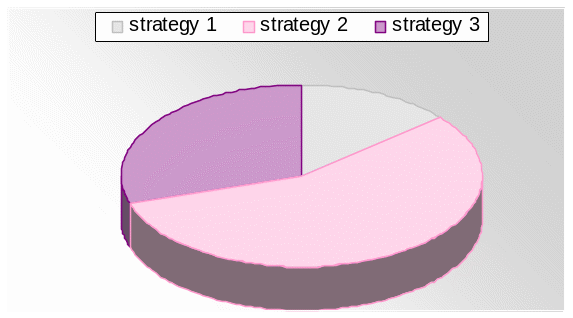
Question 11 (ii): In what ways the respondents expect that the selected strategy above would improve the quality of service delivery in the public health care sector; moreover, whether they expect that the strategy will be sustainable in the long-term:
Most of the respondents argued that the government must improve service quality in the public health sector by further funding the Ministry of Health rather than privatising the sector; they expect that in this way the people will get better services in the public hospitals. This will increase overall satisfaction and everyone in the society will be able to afford for his or her treatment and get the best possible services in lower rates; the respondents argued privatisation to be sustainable in the long-term because better service quality at fewer charges would always help to retain the public.
Question 12: Whether the respondents think that, the privatisation of public health sector in Saudi Arabia has an adverse impact on the present government:
In most of the cases, privatisation of a public sector industry means that the government of the country loses their control from the business sector that has been privatised. In case of the privatisation of public health sector as well, there were concerns that the government would face lack of administrative authority and commanding power over the health service sector because the privatised businesses are not bound to stay accountable to the government.
As a result, in case of mass privatisation of a public sector industry, there are always some levels of adverse impact on the contemporary government. In order to better address and understand this issue, this question was put forward to the surveyed population to know to what extent they believe the present government of the Kingdom of Saudi Arabia to be affected by the privatisation. In answering this question, 56 percent of the surveyed population said that the privatisation of public health sector in Saudi Arabia has an adverse impact on the present government, while the rest 44 percent disagreed with this matter; however, the result has illustrated in the figure below:
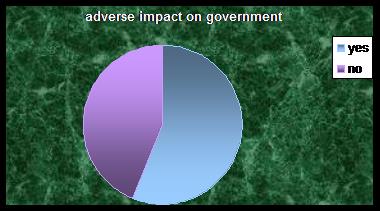
Question 13: The respondents were asked how much foreign direct investment should be permitted for the government to have some control after the privatisation
This question was put forward with the intention to know what the surveyed population think about the allowance of foreign direct investment in the Kingdom of Saudi Arabia so that the government of the country gets back some level of control over the privatisation. In order to find out this matter, a deep level of investigation was carried out; it has been noted that a large number if the population has taken the view that the level of permission for the foreign direct investment should be average, but not too high or too low.
Too high-level of foreign direct investment would mean that this would fuel up the rate of privatisation, and the entire issue would get out of control of the government. In addition, too low-level of foreign direct investment would mean that the country’s economic growth would slow down to a vast extent because foreign direct investment generates a great level of gross domestic product in the country. In answering this question, 23 percent of the surveyed population thought that the level of foreign direct investment should be restricted to 26%, and 44 percent of the surveyed population thought that the level of foreign direct investment should be restricted to 49%. On the other hand, 25 percent of the population thought that it should be limited to 51%, and eight percent argued that it should be limited to 74%.
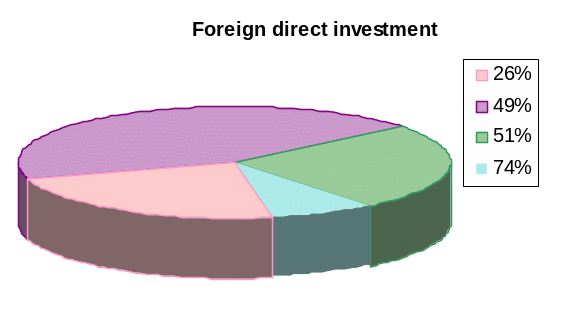
Discussion
Development toward privatization
Healthcare is one of the most important segments for privatization agenda in this nation; therefore, the government has intended to increase investment in healthcare infrastructure along with development of public-private health partnerships to meet demand for medical services with skilled workforce (Colliers International 2012, Ahmed 2013; WHO 2013; Akhtar & AlQuati 2013). At the same time, privatization program of public healthcare sector opens a new door to provide excellent service to the people of rural areas; however, the private initiators would require huge investment to participate in this program (Colliers International 2012; WHO 2013; Akhtar & AlQuati 2013). On the other hand, the government had invested very low parts of national GDP for the development of this sector comparing with other countries; as a result, this sector faced severe challenges in economic crisis period; however, the following figure shows the investment of different countries for the development of this sector:
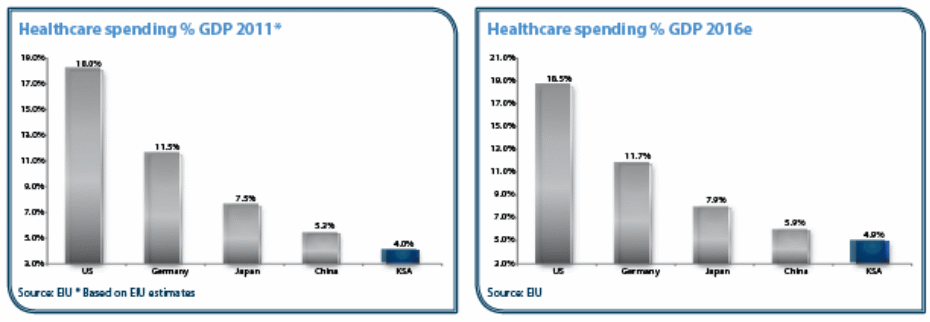
In addition, it is important to mention that the privatisation process of public healthcare sector is comparatively a slow process, though private sector operators are playing some significant roles in implementing total quality management and ensuring the modernisation of its health sector (Albejaidi 2010; Colliers International 2012; Aluwaisheg, 2013; Akhtar & AlQuati 2013). However, Wigglesworth (2008) and Aluwaisheg (2013) reported in Financial Times and Arab News that the government had increased privatisation program in order to meet surging demand for medical services; at the same time, the policy makers recommended to privatise 218 public hospitals as part of national privatization strategy; however, the next table gives more information about the main industry indicators:
Table 1: Key Industry Indicators in 2009. Source: Colliers International (2012)
Non-communicable diseases, for instance, diabetes, obesity, heart disease, kidney disease, and other diseases will create a tremendous new demand to drive in rapid privatisation program while private sector participation can reduce pressure on the government (Barrage, Perillieux & Shediac 2007; Albejaidi 2010; Colliers International 2012; Ahmed 2013; Akhtar & AlQuati 2013).
The government is now funding more than 70% of the total expenditure, but it is becoming very difficult for the government to ensure “Grade A” services for the patients of non-communicable diseases; therefore, private public partnership and privatisation of public healthcare sector will play a significant role to meet future challenges (Barrage, Perillieux & Shediac 2007; Colliers International 2012). In addition, the population of KSA will be double by 2020 and the number of old people will increase by 4% in this period; therefore, the previous research on this topic demonstrated that the policy-makers suggested immediate action to face the burden of over population and health expenditures (Barrage, Perillieux & Shediac 2007; Colliers International 2012; Aluwaisheg 2013).
In this context, researchers suggested that privatisation of public health sector can be an effective solution to upgrade healthcare service since the government dominates the healthcare segment (Almalki, Fitzgerald & Clark 2011; Bagaresh 2013; Barrage, Perillieux & Shediac 2007; Wigglesworth 2008, Colliers International 2012; Aluwaisheg 2013). However, the following figure shows evolution plan for the Saudi healthcare segment in more details:
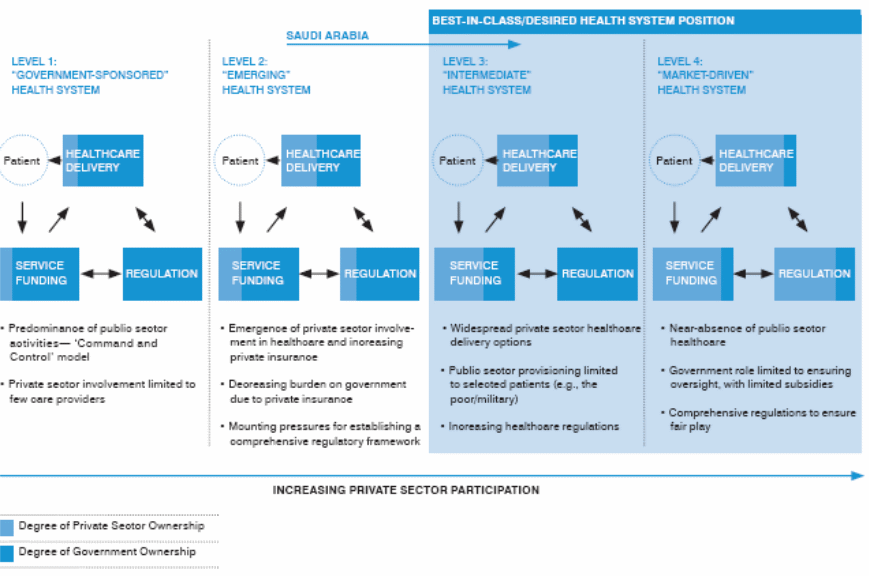
On the other hand, the government is going to establish a General Organization for Hospitals to develop public private partnerships in healthcare sector; in addition, the government will establish a national health fund to facilitate patients directly (Barrage, Perillieux & Shediac 2007).
Investment Opportunities
Barrage, Perillieux and Shediac (2007) stated that privatization would play vital role in some sector of health for which investors have great opportunity to invest in these sectors:
Table 3: Investment opportunities. Source: Self generated from Barrage, Perillieux and Shediac (2007)
Recommendations and Conclusion
Following the consideration of the above-mentioned facts regarding the impact of privatization on KSA healthcare sector over the citizens and the government, this study would now provide following recommendations –
Recommendations
- From the secondary data sources, it can be said that the government of KSA allocates very poor budgets for national healthcare sector, which is not satisfactory to the people; therefore, the government should increase national budget for the development of public healthcare service and minimise serious risk of rising cost of treatment. At the same time, the government should increase number of sources of funding in order to meet the demand of the people;
- The national healthcare system of KSA is highly based on the recommendation of the international institutes, such as WHO, GATT, IMF, and others; however, the government should lessen the dependency on the recommendations of these institutes to protect the citizens from the adverse impact of privatisation;
- In addition, the present plan for the development of healthcare system of KSA has already focused on the information technology; however, the government should concentrate on the implementation of this plan in order to digitalise the healthcare service for the citizens and enhance emergency medical services;
- Private healthcare service providers play and will continue to play an even more significant and crucial role to save the life of the citizens from the non-communicable diseases including diabetes, hypertension, obesity, heart disease and kidney disease; however, the poor people may fail to take proper treatment due to lack of infrastructural development in this sector. In this context, the policy makers should establish more public healthcare centre in order to provide proper treatment and minimise death rate for chronic non-communicable diseases since above 71% citizens died in Saudi Arabia for these diseases; moreover, they can focus on the concept of private public Partnership (PPP) along with privatisation program
- At the same time, the government and policy makers of this country should scrutinise the model of healthcare system of the developed countries like Germany, United Kingdom, Canada, and the USA in order to strengthen the health sector. In addition, it is important to give more effort to implement TQM techniques in healthcare services as it is the heartbeat of the health service delivery
- More research is required on the healthcare sector of the developed countries and other GCC countries in order to address the drawbacks of the present system and reduce the adverse impact of privatisation of public healthcare sector on citizens and government of Saudi Arabia
- On the other hand, human resource development is one of the key challenges for the government because both the public and private healthcare sector of the country heavily depends on the expatriates; in such circumstance, the government should increase investment in order to face the challenges related to the shortage of local healthcare professionals, for example, physicians, nurses, and pharmacists. In this context, the government should develop a long-term strategic plan in order to increase efficient workforce for the healthcare sector, for instance, the government should develop and oversee the implementation process of the regulations, increase investment to establish medical colleges, health institutes, and training centres, provide more scholarship, and apply non-conventional educational system and so on
- From the above discussion, it can be said that the high rate of staff turnover and overall unsteadiness among the employees in the private organisations create high costs of medical expenditure from a general viewpoint. Therefore, this study would recommend the policy makers of the KSA to increase healthcare facilities in the public hospitals to make this sector more reliable for the people of this country and to increase return on investment
- The government is required to concentrate more on the implementation process of Cooperative Health Insurance Law to protect the employees from the risk of unexpected accident, impulsive injury, and unanticipated events by ensuring financial support to cover all costs of treatment and medical facilities
Conclusion
Public healthcare sector is influenced for many external and internal factors, which encourage the policy-makers to drive in privatisation; this, for example, includes the impact of globalisation, increase in competition, lack of expert workforce, ineffective total quality management system in the public hospitals, outstanding service in private healthcare centres, and reliance of the people on the private service providers. On the other hand, it has been identified that the poor people of this country would not be able to take treatment facilities if the government emphasises more on the privatisation process since private hospitals take high cost for treatment; as a result, a significant part of the people of rural areas would be outside the treatment.
From the above discussion, it can be said that privatisation of public healthcare sector has both positive and negative impact on the citizens and on the government of Saudi Arabia; however, this research paper has analysed the key issues on privatisation of public healthcare sector in order to provide suggestion to face future challenges. However, the government should invest more for further research on the healthcare market of KSA in order to assess the present condition and to prepare a strategic plan to recommend a realistic approach of privatisation program, which will assist in increasing healthcare facilities through successful privatisation program by attracting investors and other partners.
Reflection
At the beginning, I felt it very difficult to conduct a dissertation regarding the privatisation of the public healthcare system in Saudi Arabia due to lack of my knowledge and wisdom in this area. I decided to read the literatures regarding the privatisation processes globally specially on its implication over the public health sector. Such investigation on the literature provided me with a sense that privatisation of public service is a way out for the governments globally to reduce pressure over the budget allocation while Saudi Arabia is not separate from this global wave.
Then, I proceeded to the next step to identify the background problem in this area and underlying research gap to settle the aim and objective of the dissertation; therefore, I started to write the Introduction of this paper (although I was in suspicion with my work at this stage). After completing the first chapter, I felt it necessary to engage with a right research method; however, I found it very difficult to depend on the primary data for the study, as there was no research grant to conduct field survey. Thus, I decided to engage both primary and secondary data in order to attain the objectives of this research.
Subsequently, I designed the research questions for the study and in the literature, I have endowed all my effort to find the answers of those questions from the theoretical perspective; however, this attempt made me confident that I have attained enough courage to take any challenge to conduct research work both for academic and business needs. During the formulation of the findings, discussions, recommendations, and conclusion, it was very thrilling to think that I have done something that would contribute a little to the academic world and to the elite researchers working in the field of the privatisation of the public healthcare system in Saudi Arabia.
Reference List
Ahmed, M 2013, Kingdom of Saudi Arabia: Healthcare Overview,
Akhtar, S & AlQuati, S 2013, KSA Medical Healthcare Sector, Web.
Albejaidi, F, M 2010, ‘Healthcare System in Saudi Arabia: An Analysis of Structure: Total Quality Management and Future Challenges’, Journal of Alternative Perspectives in the Social Sciences, vol. 2, no. 2, Web.
Almalki, M, Fitzgerald, G & Clark, M 2011, ‘Health care system in Saudi Arabia: An overview’, Eastern Mediterranean Health Journal, vol. 17, no. 10.
Aluwaisheg, A, A 2013, When privatization goes wrong.
Bagaresh, A 2013, Accession of Kingdom of Saudi Arabia’s To World Trade Organization and Its Benefits, Web.
Barrage, G, Perillieux, R & Shediac, R 2007, Investing in the Saudi Arabian Healthcare Sector, Web.
Colliers International 2012, Kingdom of Saudi Arabia Healthcare Overview, Web.
WHO 2013, Country Cooperation Strategy for WHO and Saudi Arabia 2012–2016,.
Wigglesworth, R 2008, Saudi Arabia eyes healthcare privatisation.